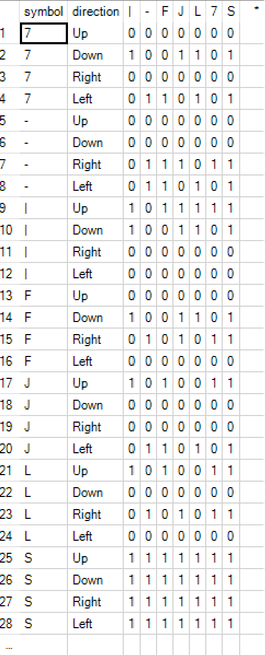General Discussions
Discuss any topics that are not product-specific here.- Community
- :
- Community
- :
- Participate
- :
- Discussions
- :
- General
- :
- Re: Advent of Code 2023 Day 10 (BaseA Style)
Advent of Code 2023 Day 10 (BaseA Style)
- Subscribe to RSS Feed
- Mark Topic as New
- Mark Topic as Read
- Float this Topic for Current User
- Bookmark
- Subscribe
- Mute
- Printer Friendly Page
- Mark as New
- Bookmark
- Subscribe
- Mute
- Subscribe to RSS Feed
- Permalink
- Notify Moderator
Discussion thread for day 10 of the Advent of Code - https://adventofcode.com/2023/day/10
- Labels:
-
Advent of Code
- Mark as New
- Bookmark
- Subscribe
- Mute
- Subscribe to RSS Feed
- Permalink
- Notify Moderator
Cool problem, good applications from Graph theory. Kind of "cheated" (brute forced/found a pattern in the data) to speed up initial solving time. Then went back and improved the Workflows to make them more generalized.
What follows is the algorithm I used in addition to pictures of my workflows (read at your own risk)
For part 2, we now make use of some data we collected as the loop of pipe was discovered, namely whether we turned left, right, or not at all (denoted -1, 1, 0, respectively). The trick here is that if you add all the turn values together, you can determine which side of the loop of pipe the interior is on since the interior will always be on the same side as the loop is traversed (To better understand this principle: imagine standing at the edge of a swimming pool such that the pool is to your right. If you then begin walking all around the pool to get back where you started, the pool will always be to your right). The reason that the sum of all the turn values allows you to know which side of the path is the interior is that in order to walk around the interior of a loop, you will necessarily have to turn more in the direction of the interior than you do away from it. Simplifying the pool example, imagine you stand next to a square pool with the water on your Right. Walking around the pool, you will have turned Right 4x before returning to the start.
Now that you know which side of the loop the interior is on, you can determine which interior points are immediate neighbors pipes in the loop and then do what is essentially a Breadth First Search (BFS) of all of those points to get all interior points of the loop. The count of those points should give you your answer.
Workflow:

Build Pipe Loop Macro:

Find Interior Points Macro:

- Mark as New
- Bookmark
- Subscribe
- Mute
- Subscribe to RSS Feed
- Permalink
- Notify Moderator
Coordinates always trip me up, but I am proud of my part 2 solution which I was able to accomplish in a few tools after my original macro. As a bonus I got some really neat visualizations from it. I'm slowly getting better at iterative macros and coordinate problems like these!
Part 2: Yay spatial tools! Created points for the points along the path, built a sequence polygon, and then used a spatial match to determine which points were within the polygon. I beat my head against a wall trying to figure out how to determine which points were bound by the loop within my iterative macro, until I remembered the amazing spatial tools available in Alteryx :) It took me a bit to figure out how to get my iterative macro to output the points in the correct sequence, but a very simple tweak fixed that for me (after lots of trial and error).
Workflow:

Mapping table of valid path values:

Iterative Macro:

Spatial Visualization of my pipe loop:

Visualization of the points bound within the pipe loop:

- Mark as New
- Bookmark
- Subscribe
- Mute
- Subscribe to RSS Feed
- Permalink
- Notify Moderator
Day10 is so hard again.
It took 4.5 hours to create WF but process is completed in 2min for P1 and P2.
- Mark as New
- Bookmark
- Subscribe
- Mute
- Subscribe to RSS Feed
- Permalink
- Notify Moderator
My Sunday comes to an end while solving this.

- Mark as New
- Bookmark
- Subscribe
- Mute
- Subscribe to RSS Feed
- Permalink
- Notify Moderator

- Mark as New
- Bookmark
- Subscribe
- Mute
- Subscribe to RSS Feed
- Permalink
- Notify Moderator
Tough challenge.
The macro to search for routes was also completed after some twists and turns, but it took quite some time until it worked properly. And my workflow is also messy.



- Mark as New
- Bookmark
- Subscribe
- Mute
- Subscribe to RSS Feed
- Permalink
- Notify Moderator
Solution

Part 1 macro

Part 2 map

- Mark as New
- Bookmark
- Subscribe
- Mute
- Subscribe to RSS Feed
- Permalink
- Notify Moderator
Make Group tool is useful in case like D10P1. Here is how to create groups with Make Group tool without macro.

1) Create X-Y coordinates as usual
2) Create 'neighborhood' coordinate by two Generate Rows tool for X & Y respectively. For D10P1 case, they can have 2 neighborhoods.

3) Find the ID of neighborhood points, and create ID-ID mapping table

4) Count ID-ID combination, and if count=2 those ID-ID pair is deemed connected.
5) Go to Make Group tool, and you get grouping data like this

- Mark as New
- Bookmark
- Subscribe
- Mute
- Subscribe to RSS Feed
- Permalink
- Notify Moderator
-
.Next
1 -
2020.4
1 -
AAH
3 -
AAH Welcome
8 -
ABB
1 -
Academy
176 -
ADAPT
9 -
ADAPT Program
1 -
Admin
1 -
Administration
2 -
Advent of Code
99 -
AHH
1 -
ALTER.NEXT
1 -
Alteryx Practice
371 -
Analytic Apps
6 -
Analytic Hub
2 -
Analytics Hub
4 -
Analyzer
1 -
Announcement
67 -
Announcements
25 -
API
3 -
App Builder
8 -
Apps
1 -
Authentication
3 -
Automation
1 -
Automotive
1 -
Banking
1 -
Best Practices
3 -
BI + Analytics + Data Science
1 -
Bugs & Issues
1 -
Calgary
1 -
CASS
1 -
CData
1 -
Certification
224 -
Chained App
2 -
Clients
3 -
Common Use Cases
2 -
Community
688 -
Configuration
1 -
Connect
1 -
Connecting
1 -
Content Management
4 -
Contest
25 -
Contests
1 -
Conversation Starter
145 -
COVID-19
15 -
Data
1 -
Data Analyse
2 -
Data Analyst
1 -
Data Challenge
143 -
Data Connection
1 -
Data Investigation
1 -
Data Science
91 -
Database Connection
1 -
Database Connections
3 -
Datasets
2 -
Date type
1 -
Designer
1 -
Designer Integration
4 -
Developer
3 -
Directory
1 -
Documentation
1 -
Download
3 -
download tool
1 -
Dynamic Input
1 -
Dynamic Processing
1 -
dynamically create tables for input files
1 -
Email
1 -
employment
1 -
employment opportunites
1 -
Engine
1 -
Enhancement
1 -
Enhancements
2 -
Error Messages
3 -
Event
1 -
Events
77 -
Excel
1 -
Feedback
2 -
File Browse
1 -
Financial Services
1 -
Fun
127 -
Gallery
2 -
General
23 -
General Suggestion
1 -
Guidelines
13 -
Help
71 -
hub
2 -
hub upgrade 2021.1
1 -
Input
1 -
Install
2 -
Installation
4 -
interactive charts
1 -
Introduction
25 -
jobs
2 -
Licensing
2 -
Machine Learning
2 -
Macros
3 -
Make app private
1 -
Marketplace
2 -
Maveryx Chatter
5 -
meeting
1 -
migrate data
1 -
Networking
1 -
New comer
1 -
New user
1 -
News
25 -
ODBC
1 -
Off-Topic
100 -
Online demo
1 -
Output
2 -
PowerBi
1 -
Predictive Analysis
1 -
Preparation
3 -
Product Feedback
1 -
Public Gallery
1 -
Question
1 -
queued
1 -
R
1 -
Reporting
1 -
reporting tools
1 -
Requirements
1 -
Resource
99 -
resume
1 -
Run Workflows
10 -
Salesforce
1 -
Santalytics
9 -
Schedule Workflows
6 -
Search Feedback
62 -
Server
2 -
Settings
2 -
Setup & Configuration
5 -
Sharepoint
2 -
survey
1 -
System Administration
4 -
Tax & Audit
1 -
text translator
1 -
Thursday Thought
53 -
Tips and Tricks
6 -
Tips on how to study for the core certification exam
1 -
Topic of Interest
156 -
Udacity
2 -
User Interface
2 -
User Management
5 -
Workflow
3 -
Workflows
1
- « Previous
- Next »






